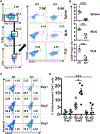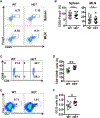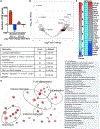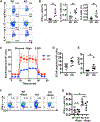Splicing factor SRSF1 is indispensable for regulatory T cell homeostasis and function
- PMID: 34233194
- PMCID: PMC8476088
- DOI: 10.1016/j.celrep.2021.109339
Splicing factor SRSF1 is indispensable for regulatory T cell homeostasis and function
Abstract
The ability of regulatory T (Treg) cells to control the immune response and limit the development of autoimmune diseases is determined by distinct molecular processes, which are not fully understood. We show here that serine/arginine-rich splicing factor 1 (SRSF1), which is decreased in T cells from patients with systemic lupus erythematosus, is necessary for the homeostasis and proper function of Treg cells, because its conditional absence in these cells leads to profound autoimmunity and organ inflammation by elevating the glycolytic metabolism and mTORC1 activity and the production of proinflammatory cytokines. Our data reveal a molecular mechanism that controls Treg cell plasticity and offer insights into the pathogenesis of autoimmune disease.
Keywords: SRSF1; T cells; Treg; autoimmunity; cytokines; immune homeostasis; immune regulation; inflammation; mTOR pathway; splicing factor.
Copyright © 2021 The Author(s). Published by Elsevier Inc. All rights reserved.
Conflict of interest statement
Declaration of interests The authors declare no competing interests.
Figures







Similar articles
-
Splicing factor SRSF1 controls autoimmune-related molecular pathways in regulatory T cells distinct from FoxP3.Mol Immunol. 2022 Dec;152:140-152. doi: 10.1016/j.molimm.2022.10.017. Epub 2022 Nov 8. Mol Immunol. 2022. PMID: 36368121
-
Splicing factor SRSF1 controls distinct molecular programs in regulatory and effector T cells implicated in systemic autoimmune disease.Mol Immunol. 2022 Jan;141:94-103. doi: 10.1016/j.molimm.2021.11.008. Epub 2021 Nov 25. Mol Immunol. 2022. PMID: 34839165 Free PMC article.
-
Splicing factor SRSF1 controls T cell hyperactivity and systemic autoimmunity.J Clin Invest. 2019 Dec 2;129(12):5411-5423. doi: 10.1172/JCI127949. J Clin Invest. 2019. PMID: 31487268 Free PMC article.
-
Regulatory T Cells in Autoimmunity and Cancer: A Duplicitous Lifestyle.Front Immunol. 2021 Sep 3;12:731947. doi: 10.3389/fimmu.2021.731947. eCollection 2021. Front Immunol. 2021. PMID: 34539668 Free PMC article. Review.
-
Molecular Insights Into Regulatory T-Cell Adaptation to Self, Environment, and Host Tissues: Plasticity or Loss of Function in Autoimmune Disease.Front Immunol. 2020 Sep 15;11:1269. doi: 10.3389/fimmu.2020.01269. eCollection 2020. Front Immunol. 2020. PMID: 33072063 Free PMC article. Review.
Cited by
-
Towards understandings of serine/arginine-rich splicing factors.Acta Pharm Sin B. 2023 Aug;13(8):3181-3207. doi: 10.1016/j.apsb.2023.05.022. Epub 2023 May 23. Acta Pharm Sin B. 2023. PMID: 37655328 Free PMC article. Review.
-
Splicing Factor SRSF1 Promotes Pancreatitis and KRASG12D-Mediated Pancreatic Cancer.Cancer Discov. 2023 Jul 7;13(7):1678-1695. doi: 10.1158/2159-8290.CD-22-1013. Cancer Discov. 2023. PMID: 37098965 Free PMC article.
-
Targeting SRSF1 improves cancer immunotherapy by dually acting on CD8+T and tumor cells.Signal Transduct Target Ther. 2025 Jan 22;10(1):25. doi: 10.1038/s41392-024-02118-2. Signal Transduct Target Ther. 2025. PMID: 39837814 Free PMC article.
-
Nuclear speckle integrity and function require TAO2 kinase.Proc Natl Acad Sci U S A. 2022 Jun 21;119(25):e2206046119. doi: 10.1073/pnas.2206046119. Epub 2022 Jun 15. Proc Natl Acad Sci U S A. 2022. PMID: 35704758 Free PMC article.
-
Alternative Splicing as a Modulator of the Interferon-Gamma Pathway.Cancers (Basel). 2025 Feb 10;17(4):594. doi: 10.3390/cancers17040594. Cancers (Basel). 2025. PMID: 40002189 Free PMC article. Review.
References
-
- Battaglia M, Stabilini A, Migliavacca B, Horejs-Hoeck J, Kaupper T, and Roncarolo M-G (2006). Rapamycin promotes expansion of functional CD4+CD25+FOXP3+ regulatory T cells of both healthy subjects and type 1 diabetic patients. J. Immunol. 177, 8338–8347. - PubMed
-
- Chalfant CE, Rathman K, Pinkerman RL, Wood RE, Obeid LM, Ogretmen B, and Hannun YA (2002). De novo ceramide regulates the alternative splicing of caspase 9 and Bcl-x in A549 lung adenocarcinoma cells. Dependence on protein phosphatase-1. J. Biol. Chem. 277, 12587–12595. - PubMed
Publication types
MeSH terms
Substances
Grants and funding
LinkOut - more resources
Full Text Sources
Other Literature Sources
Molecular Biology Databases
Miscellaneous

